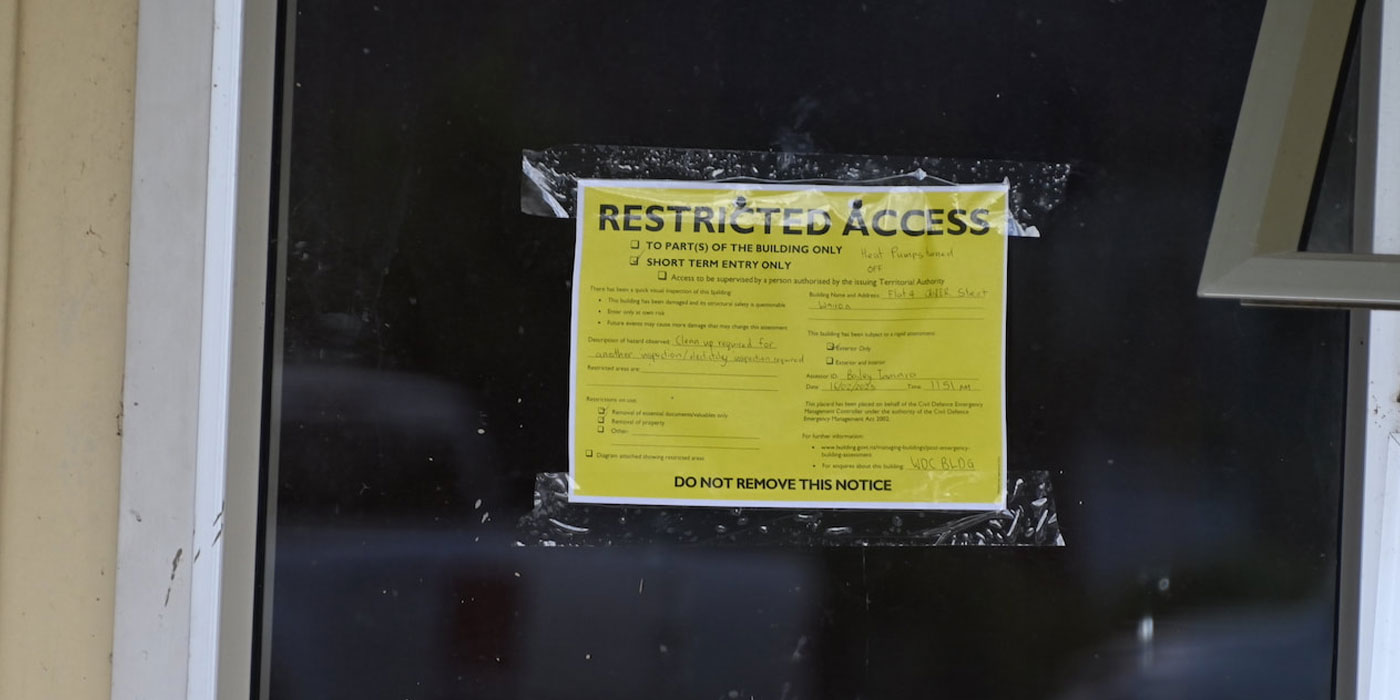As each building is assessed, a placard is attached to the building to indicate whether it can be used or if access is restricted or prohibited. When a Rapid Building Assessor assesses the usability of a building, they are required to outline this on the placard they choose to attach. It is an offence under the Building Act 2004 to damage, alter, remove or interfere with a placard and penalties may apply.
WHAT DO THE PLACARDS MEAN?
A red placard means entry is prohibited. The building may pose a significant risk to public safety, health, and wellbeing. The risk could be from the building itself, from nearby buildings or from land instability. No one should enter a building subject to a red placard unless authorised to do so.
A yellow placard means that access to all or part of a building is restricted and cannot be entered except under supervision and/or for a limited time or for a limited purpose. Part or all of the building may have sustained damage, or some areas of the building, neighbouring buildings, or land instability may pose a risk. The relevant restriction will be set out on the placard. It is important that the conditions of entry on a yellow placard are read and adhered to.
A white placard means that the building can be used. It does not mean that the building is not damaged or that it poses no risk. Building owners should check for further damage.
HOW DO I GET MY HOME REPAIRED?
In order to begin the process of repair or remediation, if you have a dwelling subject to a red or yellow placard you should first contact your insurer, who will likely arrange (or help to arrange) for more detailed engineering evaluations.
You will need to work with your local council to arrange authorised access for an appropriate professional so they can assess the damage (such as a geotechnical or structural engineer, builder, drainlayer or plumber).
The council will, if appropriate, issue authorisation to access the building. In some cases, access may be refused, for instance due to a high risk to life safety.
In the case of a red placard, it is likely that a Detailed Damage Evaluation (DDE) will need to be undertaken. It may also be recommended for a yellow or white placard.
White placard
If a building has a white placard, it is still recommended that you commission a DDE if you are concerned about the building and/or the area has suffered damage.
It is important during the response phase of an emergency event that white placards are displayed as it provides homeowners, the council and rapid building assessors proof that the building has had a rapid building assessment.
WHAT IS A DETAILED DAMAGE EVALUATION(DDE)?
- apply for building/resource consent, or discretionary exemption from the requirement for building consent, for remedial works required in order to request a placard change; or
- carry out other remedial works, for which consent is not required, that are required in order to request a placard change.
In some circumstances, a territorial authority (or the ‘responsible person’) may also seek a DDE from a building owner where the building is a hazard that impacts critically on recovery, for example, to decide whether or not a building should be urgently demolished. In some circumstances, the Building Act 2004 gives a person (often the relevant territorial authority) the power to seek a DDE from a building owner.
HOW TO GET A PLACARD REMOVED OR CHANGED
Once any appropriate work has been undertaken, contact your council to have your building’s placard status reassessed. This is to determine if the risks have been sufficiently reduced for the placard colour to be changed.
A council may request evidence from a geotechnical or structural engineer before reassessing the placard.
A reassessment of a property subject to a placard will examine the building post-repair against the risks noted in the original placard decision and other relevant information. It may be that a red placard is downgraded to a yellow, or a red placard removed altogether if the risks have been sufficiently reduced to a point where the building can be occupied. You do not need to progress down the placard system from red, yellow to white. A placard colour is a reflection of the present risk.
White placard
Leave a white placard up until you are authorised to remove it, for example, the council advises you it can be removed, or if the placard has been issued with an expiry date and that date has passed.






